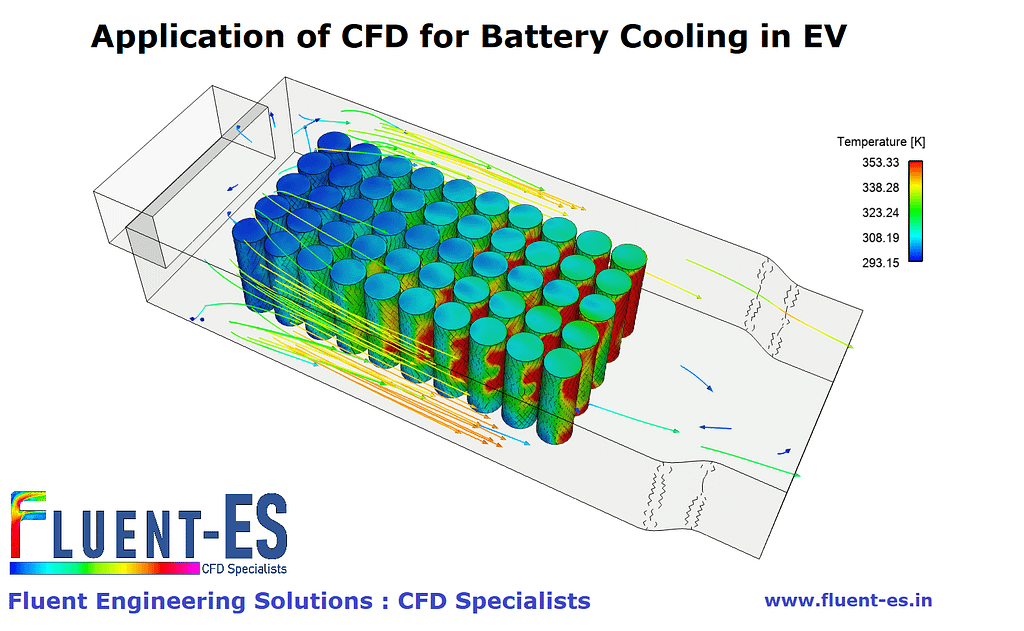Need of battery cooling
Considering the current scenario and air pollution emission of conventional IC vehicle, the future of transportation is electric vehicles. Electric vehicles doesn’t account for air pollution and provides an elegant driving experience. In addition, it has excellent torque, power, speed, and acceleration compared to traditional IC vehicles.
As the name indicate it is also commonly termed an E-vehicle and uses electrical energy to deliver mechanical moving motion. This electrical energy is stored in rechargeable batteries. There are several batteries available in the market but lithium-ion battery and lithium polymer battery are the most preferred for the EV application.
These batteries are able to deliver and store electric energy due to electrochemical reactions taking place during the charging and discharging. The rate of electrochemical reaction is influenced by the operating temperature and it is directly proportioned to the mobility of charged ion’s. Means, when battery operates at high temperature it boosts the electrochemical reaction and charged ion mobility; that fastens the rate of charging and discharging. But it comes with a cost of low battery life.
Therefore, it is recommended to use the battery at room temperature which allows for efficient working and enhanced lifecycle of battery.
In the EV, these batteries are kept in constrained space due to space limitation which accounts for excess heat generation as the surrounding more or less acts as the thermal insulation. The real problem start appearing when the EV is mobile in hot climate and specifically during the summer. There are many cases reported due to battery heating and fire issue in the last year due to inefficient management of thermal cooling in the EV.
Thermal Management strategy for Battery Cooling in EV
The thermal design aims to maintain the battery cells within a given operating temperature range so that it works more efficiently and safely throughout the lifecycle.
Considering the challenges of designing a new technology, the need for modelling and simulation tools for the creation of robust thermal management strategies is critical.
It is extremely cumbersome to balance thermal management design trade off as EV demands solutions that would not compromise on specification like weightiness, compactness, reliability, ease of service and low cost. The most recent trends in thermal management are using following cooling strategies.
- Passive cooling
- Active cooling
- Liquid cooling
Passive cooling uses the natural convection to transfer the generated heat from the batteries. It has no additional moving parts and that makes the system low cost but not much thermal effective to keep the battery temperature at desire level.
The active air cooler strategy uses a forced circulation by means of circulating fan to remove heat generated from the batteries. This is the efficient way to remove heat and keep battery cells at desire temperature. It comes with an operating cost of driving fan.
The challenge is uniform flow distribution of the air flow over the bank of batteries to serve the uniform cooling. Using the Computational Fluid Dynamics (CFD) Simulation flow path can be designed to meet the requirement in an efficient manner.
The liquid cooling is the most efficient way to remove heat from the EV batteries, since liquid has higher heat capacity than the gases. It comes with the operating cost equal to the pressure drop required for the liquid circulation through the cooling channels (cooling plate/ tube channels).
Battery Cooling using Numerical Prototype
With the help Numerical Prototype and series of CFD simulation we have provide thermal information to the manufacturer in order to keep the temperature within the costumer’s desire range.
The current case shows the typical battery arrangement enclosed in forced cooling system utilizing air flow through fans. The hot spot on the batteries are generally appeared where cooling air has minimal contact. Those battery cells are at the end of battery pack. The fluid is always try to take flow with lower resistance, hence air prefer to flow through the gaps between packing wall and battery cells which cause the low pressure drop requirement and hence the operating cost.
With series of numerical simulation performed on the battery cooling system, we can utilise the flow information to make it thermal efficient.
Given modification in the flow path had successful to enforce cooling air through gaps of battery cells to extract generated heat during charging and discharging.
Contact us for your optimal battery cooling performance.

